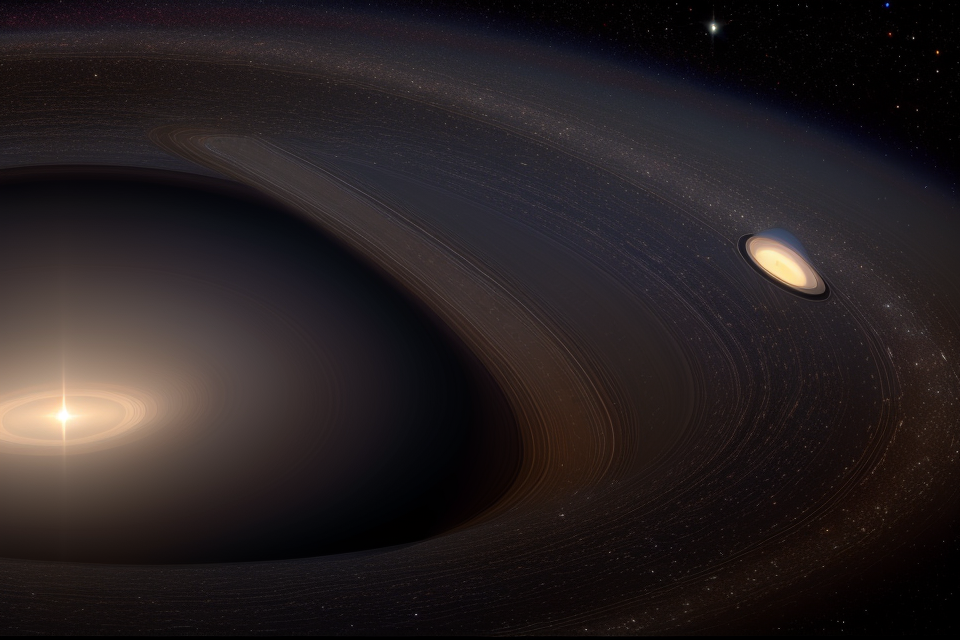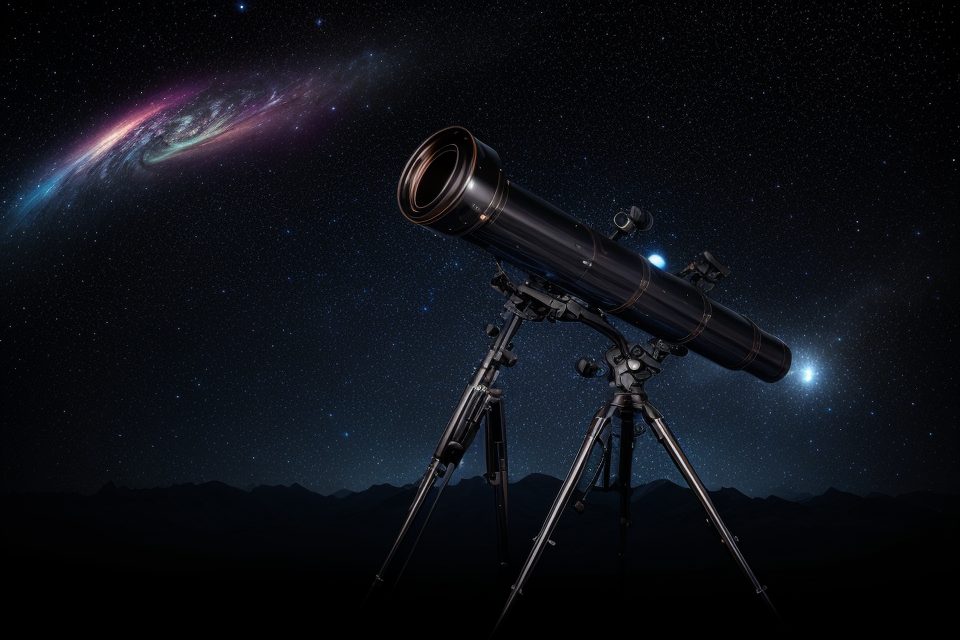As one of the most captivating planets in our solar system, Saturn is a marvel to behold. With its breathtaking rings and intriguing moons, it’s no wonder that so many of us are drawn to observe this celestial wonder. But how can we best see the intricate details of Saturn’s rings? The answer lies in the power of magnification.
In this guide, we’ll explore the optimal magnification needed to truly appreciate the beauty of Saturn’s rings. From the basics of telescope magnification to tips for enhancing your viewing experience, we’ll cover everything you need to know to unveil the wonders of Saturn for yourself. So grab your telescope, find a dark sky, and let’s get started on this incredible journey of discovery!
Understanding Saturn’s Rings
Structure and Composition
- Description of Saturn’s rings
Saturn’s rings are a stunning feature of the planetary system, comprising a vast collection of particles that orbit the planet. They are named after the ancient Roman god Saturn, who was often depicted as holding a scythe or a sickle. The rings are primarily composed of water ice, with some rocky material mixed in. The particles in the rings range in size from small dust grains to larger boulders, and they are thought to be primarily composed of material that was once part of a larger object, such as a comet or an asteroid.
- Particles and their distribution
The particles in Saturn’s rings are distributed in a remarkably even manner, with each particle orbiting the planet in a particular path. The particles are separated into seven main rings, known as the C ring, B ring, A ring, and F ring, with each ring having its own unique characteristics and properties. The particles in the rings are also thought to be in constant motion, with some particles occasionally colliding and breaking apart into smaller pieces.
- Debris and origin theories
There are several theories about the origin of the debris in Saturn’s rings. One theory suggests that the particles are the remains of a former moon that was torn apart by Saturn’s gravitational pull. Another theory proposes that the particles are the result of a collision between a comet and a larger object in the solar system, such as an asteroid. Some scientists also believe that the particles in the rings may have originated from a large impact event, such as a collision between two large objects in the solar system.
Despite the many questions that remain about the structure and composition of Saturn’s rings, they continue to fascinate scientists and amateur astronomers alike. As our understanding of these remarkable features of the solar system continues to evolve, the wonders of Saturn’s rings remain a source of endless inspiration and curiosity.
Observing Saturn’s Rings
Saturn’s rings are a breathtaking sight to behold, and with the right telescope and observation techniques, you can experience their majesty firsthand. To get the most out of your observation session, it’s important to understand the ideal times for observation, the basic telescope equipment needed, and eye safety considerations.
Ideal times for observation
The best time to observe Saturn’s rings is during the summer months, from April to October. During this time, the planet is well-positioned in the evening sky, making it easier to observe. Additionally, the ringed planet is visible for a longer period of time, giving you ample opportunity to study its rings and moons.
Basic telescope equipment
To observe Saturn’s rings, you will need a telescope with a minimum aperture of 80mm. This will provide enough light-gathering power to bring the rings into focus. Additionally, you will need a tripod to stabilize the telescope and a mount to keep it pointed at Saturn.
Eye safety considerations
Observing Saturn’s rings can be dangerous to your eyes if you don’t take proper precautions. Always wear appropriate eye protection, such as welder’s goggles or a telescope hood, to prevent damage to your eyes. Additionally, never look directly at the sun or bright planets, as this can cause permanent damage to your eyes. Always use a solar filter or other appropriate filter when observing bright objects.
Determining Magnification Needs
Saturn’s rings are a remarkable feature of the planetary system, consisting of a vast collection of particles that orbit the planet. Observing Saturn’s rings requires understanding the ideal times for observation, basic telescope equipment, and eye safety considerations. Determining the optimal magnification for observing Saturn’s rings involves considering factors such as telescope aperture, focal length, eye relief, observer’s distance, and atmospheric conditions. A recommended magnification range for observing Saturn’s rings is 100x to 500x. Choosing the right telescope for observing Saturn’s rings involves considering factors such as magnification needs, aperture, focal length, and optical quality. Advanced techniques for improved magnification include using Barlow lenses, field flattener lenses, and reducer lenses. It is essential to understand the limitations of telescope power and to take atmospheric conditions into account when determining the optimal magnification.
The Importance of Magnification
- Understanding telescope magnification
Magnification is a crucial aspect of telescope observation, as it allows observers to see distant objects in greater detail. Telescope magnification refers to the process by which the image appears larger and more detailed, allowing for a more comprehensive examination of the object in question. Understanding the basics of telescope magnification is essential for any amateur astronomer or space enthusiast. - The relationship between magnification and resolution
The relationship between magnification and resolution is critical when observing through a telescope. Resolution refers to the level of detail that can be seen in an image. As magnification increases, the resolution of the image also improves, allowing for greater detail to be seen. However, it is important to note that increasing magnification beyond a certain point can lead to a decrease in resolution, resulting in a less detailed image. - Limitations of telescope power
Telescope power is determined by the size of the objective lens or mirror, and the magnification of an image is limited by the quality of the optics and the atmosphere. Even the most powerful telescopes have limitations, and it is essential to understand these limitations when determining the optimal magnification for telescope observation. Factors such as atmospheric conditions, telescope size, and the quality of the optics can all impact the level of magnification that can be achieved, and it is important to take these factors into account when determining the optimal magnification for observing Saturn’s rings.
Factors Affecting Magnification
The process of determining the optimal magnification for observing Saturn’s rings requires an understanding of the factors that affect magnification. These factors include the telescope’s aperture, focal length, eye relief, observer’s distance, and atmospheric conditions.
- Telescope Aperture:
The size of the telescope’s aperture is a critical factor in determining the magnification needed for observing Saturn’s rings. A larger aperture allows for more light to enter the telescope, resulting in a brighter and clearer image. This, in turn, allows for higher magnification without compromising image quality. Conversely, a smaller aperture requires a lower magnification to prevent the image from becoming dim and blurry. - Telescope Focal Length:
The focal length of the telescope is another crucial factor in determining the optimal magnification. The focal length of a telescope is the distance between the primary mirror and the point where the light converges. A longer focal length results in a higher magnification, but it also means that the image will be dimmer and less stable. A shorter focal length, on the other hand, provides a brighter and more stable image but at the cost of lower magnification. - Eye Relief and Observer’s Distance:
Eye relief is the distance between the eyepiece and the observer’s eye, and it plays a significant role in determining the optimal magnification. A larger eye relief allows for a more comfortable and stable viewing experience, especially for those who wear glasses or have long sight. Observer’s distance is the distance between the observer and the telescope, and it affects the magnification needed. A greater observer’s distance requires a higher magnification to maintain a clear and detailed image. - Atmospheric Conditions:
Atmospheric conditions, such as temperature, humidity, and wind, can significantly impact the optimal magnification needed for observing Saturn’s rings. For instance, high humidity can cause the air to become unstable, resulting in a blurry image. Similarly, wind can cause the telescope to move, resulting in a shaky image. It is essential to consider these factors when determining the optimal magnification and to make adjustments accordingly.
Selecting the Right Magnification
Recommended Magnification for Saturn’s Rings
- The ideal magnification range
- Tips for achieving optimal viewing
- Importance of steady and calibrated observations
Selecting the Right Magnification
One of the most critical factors in telescope observation is the selection of the right magnification. The ideal magnification range for observing Saturn’s rings can vary depending on the size of the telescope, the quality of the optics, and the skill of the observer.
Ideal Magnification Range
For observing Saturn’s rings, a magnification range of 100x to 500x is typically recommended. This range allows for the best balance between resolving power and image stability. Higher magnifications can lead to image degradation due to atmospheric conditions, while lower magnifications may not provide enough detail.
Tips for Achieving Optimal Viewing
To achieve optimal viewing of Saturn’s rings, consider the following tips:
- Choose a night with good atmospheric conditions: Ideal conditions include clear skies, low humidity, and minimal wind. These conditions will minimize the effects of atmospheric turbulence, which can degrade image quality.
- Adjust the telescope’s focuser: Make sure the focuser is properly adjusted to ensure the eyepiece is centered and focused correctly.
- Use a high-quality eyepiece: Invest in a high-quality eyepiece designed for planetary observation. This will provide the best image quality and detail.
- Experiment with different eyepiece designs: Try different eyepiece designs, such as orthoscopic or Plössl eyepieces, to find the one that provides the best viewing experience for your eyes.
Importance of Steady and Calibrated Observations
Steady and calibrated observations are crucial for accurate and detailed observation of Saturn’s rings. This means that the telescope should be mounted on a stable and level base, and the telescope’s movements should be smooth and precise. Additionally, the telescope’s pointing should be calibrated using a method such as the “Kapteyn’s method,” which ensures accurate alignment and tracking of celestial objects.
By following these recommendations, you can ensure the best possible viewing experience when observing Saturn’s rings. The ideal magnification range, combined with the right eyepiece and observing conditions, will provide you with an awe-inspiring view of this stunning celestial wonder.
Choosing the Right Telescope for Saturn’s Rings
When it comes to observing the intricate details of Saturn’s rings, selecting the right telescope is crucial. Here are some key factors to consider when choosing a telescope for this purpose:
Selecting a Telescope Based on Magnification Needs
The first step in choosing the right telescope for observing Saturn’s rings is to determine the desired magnification. This will depend on various factors, such as the size of the rings and the observer’s preference for detail. Generally, a telescope with a higher magnification will provide more detailed views of the rings. However, it is important to note that excessive magnification can also lead to a loss of detail and image quality.
Understanding the Roles of Aperture, Focal Length, and Optical Quality
When selecting a telescope for observing Saturn’s rings, it is important to consider the roles of aperture, focal length, and optical quality. Aperture refers to the diameter of the telescope’s lens or mirror, and is a key factor in determining the amount of light that can be gathered by the telescope. A larger aperture generally results in brighter and clearer images. Focal length refers to the distance between the lens or mirror and the point of focus, and affects the magnification and field of view of the telescope. Optical quality refers to the clarity and sharpness of the images produced by the telescope, and is influenced by factors such as the quality of the lenses or mirrors and the design of the telescope.
Tips for Beginners and Experienced Observers
Whether you are a beginner or an experienced observer, selecting the right telescope for observing Saturn’s rings can be a daunting task. Here are some tips to help you make the best choice:
- Beginners may want to consider a telescope with a moderate magnification and good optical quality, as this will allow for clear and detailed views of the rings without overwhelming the observer.
- Experienced observers may be interested in a telescope with a higher magnification and excellent optical quality, as this will allow for even more detailed views of the rings and other celestial objects.
- Regardless of experience level, it is important to consider the size and weight of the telescope, as well as the ease of use and portability. A telescope that is easy to set up and transport can be a great asset for observing from different locations.
Overall, selecting the right telescope for observing Saturn’s rings requires careful consideration of factors such as magnification needs, aperture, focal length, and optical quality. By taking the time to evaluate these factors, you can choose a telescope that will provide you with the best possible views of this incredible celestial object.
Advanced Techniques for Improved Magnification
Enhancing the magnification of your telescope observation can reveal even more details of Saturn’s rings. Here are some advanced techniques to improve your magnification:
Using Barlow Lenses
A Barlow lens is a simple yet effective device that can increase the magnification of your telescope. It works by increasing the effective focal length of your telescope, which in turn increases the magnification. There are different types of Barlow lenses available, such as singlet, achromatic, and doublet lenses. Each type has its own characteristics and benefits, so it’s important to choose the right one for your telescope and observing conditions.
To use a Barlow lens, simply insert it between the eyepiece and the telescope. The magnification will depend on the Barlow factor, which is usually indicated on the lens. For example, a 2x Barlow lens will double the magnification of your telescope.
Techniques for Image Enhancement
In addition to using Barlow lenses, there are other techniques you can use to enhance the image quality and magnification of your telescope observation. One such technique is using a field flattener lens, which corrects the curvature of the field of view and reduces coma and other aberrations. Another technique is using a reducer lens, which reduces the focal length of your telescope and allows you to use longer focal length eyepieces for greater magnification.
Tips for Working with Larger Aperture Telescopes
If you have a larger aperture telescope, you may want to experiment with different eyepieces to find the optimal magnification for your particular setup. You can also try using a different type of eyepiece, such as a Plössl or Orthoscopic eyepiece, which can provide a wider field of view and greater eye relief.
Remember that increasing magnification also increases the image size, so make sure your telescope and mount can handle the additional weight and stress. It’s also important to choose eyepieces with appropriate eye relief and field of view for your individual needs and preferences.
FAQs
1. What are Saturn’s rings and how can they be seen?
Saturn’s rings are a spectacular natural phenomenon that can be observed through a telescope. They are a system of planetary rings around the planet Saturn, consisting of small ice particles made of water, ammonia, and other substances. The best time to observe Saturn’s rings is during the summer months when the planet is well-positioned in the night sky.
2. How can I determine the optimal magnification for viewing Saturn’s rings?
The optimal magnification for viewing Saturn’s rings depends on various factors such as the size of your telescope, the quality of your eyepiece, and the atmospheric conditions. A good rule of thumb is to use a magnification of around 100x to 200x, which will provide a clear and detailed view of the rings. However, it’s essential to experiment with different magnifications to find the optimal setting for your specific telescope and observing conditions.
3. What type of telescope is best for viewing Saturn’s rings?
Any telescope with a magnification of 100x to 200x can be used to view Saturn’s rings. However, a larger telescope with a longer focal length will provide a more detailed and clearer view of the rings. Refractors and catadioptric telescopes are particularly well-suited for viewing planets due to their high magnification capabilities and excellent image quality.
4. Can I use a camera or smartphone to capture images of Saturn’s rings?
Yes, you can use a camera or smartphone to capture images of Saturn’s rings through your telescope. However, it’s important to use a compatible telescope eyepiece or an appropriate camera adapter to connect your camera to the telescope. Additionally, you may need to experiment with different settings, such as exposure and focus, to achieve the best possible image quality.
5. What are the best observing conditions for viewing Saturn’s rings?
The best observing conditions for viewing Saturn’s rings are during the summer months when the planet is well-positioned in the night sky. Ideally, the sky should be clear and free of clouds or pollution, which can obstruct the view. It’s also important to observe Saturn when it is near its closest approach to Earth, which occurs every 15-20 years. During this time, the planet appears larger and brighter in the sky, making it easier to observe the rings in detail.



